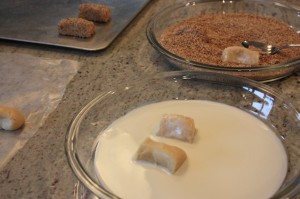
Italian Seed Cookies
New Orleans is celebrating yet again. Today, the City comes together to honor St. Joseph, foster father of Jesus and the patron saint of many including Sicilians, laborers, travelers, house hunters, the persecuted, the poor, the aged and the dying. Locals express their devotion through the centuries-old Sicilian tradition of building elaborate food altars to commemorate the relief St. Joseph provided them during the famine back in the Middle Ages, to give thanks for answering a special prayer and to express gratitude for his constant guidance and intercession. These altars are erected in private homes, parish halls, churches, schools, Italian restaurants and even some neighborhood grocery stores. A list of altars hosted by the archdiocese and public entities, along with visiting hours and related info, is printed in the newspaper and on various websites. Visitors are welcome to attend all church-sponsored and public food altars as well as those held in any private home whose entry way is adorned with fresh green branches or a green wreath. Visitors can participate in the altar blessings, share in the food and make a donation. Everyone visiting an altar receives a small gift bag filled with cookies, a “lucky” (fava) bean, a cube of St. Joseph’s bread and a prayer card. Any food remaining and donations collected at the end of the feast are given to the poor or donated to a specific charity designated by the host.
Preparations for this feast day begin weeks and even months in advance. Traditional altars are built with three tiers representing the Holy Trinity. A statute of St. Joseph is placed in the center and various other statues, candles, flowers and symbolic items are placed about. The food that adorns each altar has special significance too. Breads are baked into shapes that represent St. Joseph and the life of Christ. A toasted bread crumb topping called Mudrica, representing sawdust from St. Joseph the carpenter, is sprinkled on dishes like Pasta Milanese. Other pasta dishes, Stuffed Artichokes, fresh fruits, vegetables and wine all come into play. As does whole fish and other types of seafood. Because this is a Lenten celebration, there is no meat on the altars. But it’s not missed. Sweets make a strong showing too in the form of elegant pastries and cookies. One cookie you’ll find on most altars is the Italian Seed Cookie. These are my favorite. They’re crisp and light with a toasted, subtly sweet, vanilla flavor. They’re what I call the perfect coffee companion. When I was a kid, I used to make dozens upon dozens of these cookies with my dear friend Sybil. Not for St. Joseph’s Day altars but for Christmas gifts. It’s been years since I’ve seen Sybil. But I think of her every Christmas and St. Joseph’s Day and every time I see, taste or think about Italian Seed Cookies!
For the record, this recipe is not all my own. It’s a combination of several Italian Seed Cookie recipes I’ve collected over the years (unfortunately, none of which I can tie back to an original source) combined with my best recollection of how Sybil and I prepared them. The one step I clearly remember is rolling our formed cookies in cream and then sesame seeds. Not all recipes call for finishing the cookies this way, but I think it makes all the difference. From a preparation standpoint, buy the shortening sticks and not the tub–much easier to measure out. And to avoid breaking the bank, steer clear of those little bottles of sesame seeds in the spice section of the grocery store. Shop instead at a store that sells bulk seeds and nuts. When I’m home, I stock up on several pounds of sesame seeds from Central Grocery in the French Quarter and store them in the freezer. Nor-Joe’s in Old Metairie also sells them this way. Outside of New Orleans, Whole Foods is probably your best bet.
Italian Seed Cookies Recipe
3 1/2 cups all purpose flour
2 teaspoons baking powder
1/8 teaspoon salt
1/2 cup unsalted butter
1/2 cup vegetable shortening
1 cup sugar
1 egg
3 teaspoons pure vanilla extract
1/2 cup heavy cream, for dipping
1 1/2 cups sesame seeds, for coating
Preheat oven to 350 degrees. Lightly grease a couple of large baking sheets with cooking spray; set aside. In a large bowl, combine the flour, baking powder and salt; set aside. In the bowl of an electric mixture with paddle attachment, cream together the butter, shortening and sugar until light and fluffy. Beat in egg and vanilla. Gradually add the flour mixture. Beat until dough is soft and smooth. Pour the cream into a medium bowl. Pour the sesame seeds into a shallow dish. To form the cookies, scoop out 1/2 cup of dough, form into a ball, place dough on a clean surface and roll out into a long log about 1-inch in diameter. Cut log into 2-inch pieces.

Dip each piece into cream and then roll in sesame seeds. Shake off excess seeds and place on prepared baking sheet.

Repeat with remaining dough. Bake until cookies are firm and light golden brown, about 20-25 minutes. Cool on a wire rack. Store in an airtight container at room temperature for up to 2 weeks or freeze for up to 3 months. Makes about 6 dozen cookies.
Genêt



